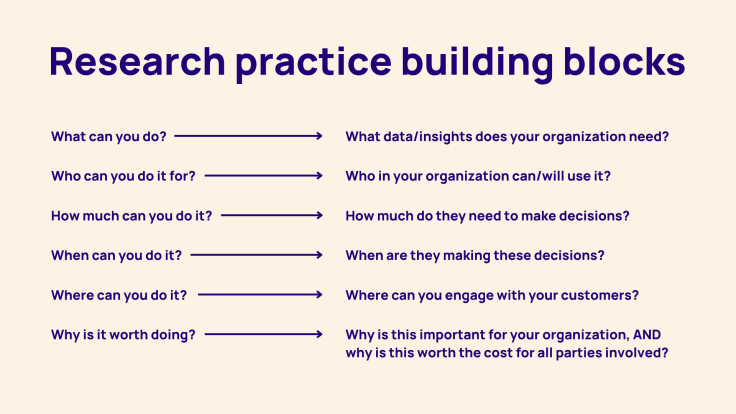Five principles for scaling and democratizing product research

Today’s leading organizations know that product research is a competitive advantage. As the appetite for quality user insights grows exponentially, it becomes vital to support the organization in its learning. Unfortunately, not all organizations are ready to hire more researchers. An NNG study shows that in 2020 the average ratio of researchers in product teams was one researcher to five designers to 50 developers.
In this scenario, democratizing research can help scale the impact of research by educating and empowering every team in the organization to engage with customers more rigorously, get access to high-quality insights, and make evidence-based decisions.
At Maze, our mission is to empower product teams to test, learn, and act fast. We believe anyone should be able to access invaluable user insights that inform product and business decisions. Our goal with this article is to provide you with five guiding principles that you can follow to start scaling and democratizing product research in your organization. We’ll cover how to best support the organization’s research needs and enable stakeholders to run their own research confidently and responsibly.
To identify these principles, we’ve interviewed Behzod Sirjani, Founder of Yet Another Studio, and UX leaders and mentors from ADPList, including Hailey Clausen, Product Designer at Clari, Roberta Dombrowski, VP of User Research at User Interviews, Edie Cao, Sr. Lead UX Researcher at Varis, and many more.
Know your organization
There’s no one-size-fits-all approach to successfully scaling and democratizing product research. Each organization is different—in terms of goals, team composition, and UX maturity—and what works well for one company may not work for another.
That’s why the first thing to do before determining how to scale research is to understand how your organization works, how it makes decisions, and what its needs and goals are. Here are a few questions to keep in mind:
What does your organization look like?
How does your organization make decisions?
What decisions are being made, and who’s involved in making those decisions?
What kind of evidence do decision-makers need to make informed decisions?
How do they get access to this evidence?
You can use many methods to answer these questions, including observing work practices and running interviews with stakeholders. Knowing your organization and its research needs is key to determining how to satisfy those needs in a better way.
Close the gaps between what your research practice provides and what your organization needs
In his essay, The Organizational Appetite for Research, Behzod Sirjani, founder of Yet Another Studio, states that “a successful research practice has alignment between how you can feed your organization and what their appetite looks like.”

Compare the answers to the questions above to identify gaps between your research capacity and your organization’s research needs. Are product teams getting access to the evidence they need to make informed decisions? Are there ways to make decisions more effectively?
Once you identify the gaps and opportunities for improving the decision-making process, think about who’s best suited to participate in research and gather evidence to help close those gaps. For example, designers, product managers, product marketers, and engineers might have some experience conducting research or be interested in learning and practicing.
If there are stakeholders who are already engaging with customers and collecting feedback to inform their decision, determine how you can help them make those interactions more rigorous to get relevant, actionable insights.
“There is an opportunity to learn with each user interaction. We encourage all user-facing teams to gather insights and feedback based on routine conversations they’re already having. Our sales, customer success, and support teams can provide insights that help consistently inform product and design teams.” - Hailey Clausen, Product Designer at Clari
Make it safe for everyone to participate in research
Democratizing product research doesn’t come without risks. You’ll need to find the right balance between allowing everyone to access the insights they need and ensuring every research activity is conducted responsibly and effectively.
Jeanette Fuccella, Director of Research & Insights at Pendo.io, defines the risk associated with research as the risk of getting it wrong and provides a framework for prioritizing user research that aims to help researchers identify and mitigate risk. (You can also check out the Method in Madness article where they break this framework down and explain it more detail).
One way to make it safe for everyone to participate in research is to establish what research is appropriate for a democratized practice and what responsibilities you’re willing to share with your stakeholders. Reflect on the following:
What types of research should you allow non-researchers to do?
Where should they partner with a researcher?
When do you think a project is better led by a researcher?
There are no right or wrong answers here. Think about your specific needs to determine what approach will work best for your organization.
For example, at User Interviews, foundational research projects like mental model studies or strategy questions are led exclusively by the UX research team. At the same time, researchers are educating and empowering other teams to run their own research.
“When scaling and democratizing research, UX researchers focus more on enabling others to learn and ensuring we’re focusing on the right things to learn.” - Roberta Dombrowski, VP of User Research at User Interviews
Educate and train stakeholders to run their own research
Now that you have the appropriate safeguards in place, it’s time to educate your stakeholders on what quality research looks like and how to engage with customers, gather accurate insights, and act on them to make better decisions.
Create a training program
One of the best ways to educate stakeholders to run their own research is to create a research training program, but you can also get started by holding dedicated workshops, lunch & learns, and office hours.
No matter what initiative you choose, think about your audience and their learning goals. Do they have any experience running research? Are they looking for a basic understanding of product research or a more practical approach?
Once you have identified your audience, decide which topics you’ll need to cover. These can range from planning a study and choosing the right research method to engaging with customers and avoiding leading questions.
Provide supporting resources
Equip non-researchers with the necessary tools and resources to run their research activities autonomously and effectively. Valuable resources include decks or knowledge banks with research principles and best practices, playbooks and step-by-step guides with actionable advice, research tools for streamlining the research process, templates for conducting a study, reaching out to customers, writing research reports, and more.
Put theory into practice
There’s no better way to learn than by doing. That’s why you should encourage non-researchers to take part in research activities. “Every team member should feel comfortable getting in touch with customers regularly,” explains Marion Kammerer, Senior Product Designer at EstimateOne. “This can start as observing research sessions and asking a few questions but ideally leads to more involvement and interest in research activities.”
Depending on your stakeholders’ experience and the type of research, provide them with the support they need and give them actionable feedback to keep learning and improving. For example, you could pair non-researchers with experienced researchers or hold office hours to guide them and answer all research-related questions they might have.
“Training and supporting non-researchers is a critical aspect in many startup product teams. What is important is ensuring a training and education budget and providing a reading list of key books and blogs. Then it’s leading by example, inviting folks to the process, and empowering them to try it themselves. The end result is more people are aware of the problem space and the user needs, independent of the solution space.” - Joshua Lederman, VP of Product at Stealth
Assess and iterate
Finally, remember that scaling research is an ongoing process. Things might not go as planned at first, but with time you’ll understand what approach works best for your organization and yields the best results. Try to:
Start small by focusing on a few initiatives or a specific group of stakeholders
Talk to your stakeholders and listen to their feedback to learn more about what’s working, the main benefits and challenges, areas of improvement, and opportunities
Learn along the way and keep iterating to make the process of democratizing research as successful as possible
“It takes time to scale and democratize research. Non-researchers have different mental models of what it means to do research. Therefore, most of the upfront effort is helping folks unlearn misconceptions and learn fundamentals and best practices,” says Edie Cao, Sr. Lead UX Researcher at Varis. “Research practices lie on a maturity curve. Processes start scrappy and lean—and that’s ok. You’ll iterate and refine in time. Meet folks where they are, and with consistency and effort, you’ll scale your practice to where your org needs it to be.”
Maximizing the impact of product research
Empowering product teams to learn is a great way to expand the impact of product research across the company. We hope these five principles can help you start the process of scaling research in your organization. With adequate education and safeguards, everyone can play an active role in research and make more informed decisions.
If you’re looking for more best practices, real-life examples of how UX leaders apply these principles in their organizations, and insights on how the role of the UX researcher is evolving, check out our Maze x ADPList Playbook: Democratizing Research to Deliver Impact at Scale.
Written by Jonathan Widawski, Co-founder & CEO, Maze. Jonathan Widawski is a veteran Product Designer & former UX teacher. As a UX lead working with clients like McKinsey, Rocket Internet & PSG, he saw first-hand how hard it is for product teams to get the data, insights, and feedback they need to make confident design decisions. Now he's co-founded Maze, a product research platform to enable companies of all sizes to test and learn rapidly.

Users report unexpectedly high data usage, especially during streaming sessions.
09:46AM24 Sep, 2024
Users find it hard to navigate from the home page to relevant playlists in the app.
11:32AM9 Mar, 2024
It would be great to have a sleep timer feature, especially for bedtime listening.
15:03PM13 May, 2024
I need better filters to find the songs or artists I’m looking for.
4:46PM15 Feb, 2024Log in or sign up
Get started for free
or
By clicking “Continue with Google / Email” you agree to our User Terms of Service and Privacy Policy


